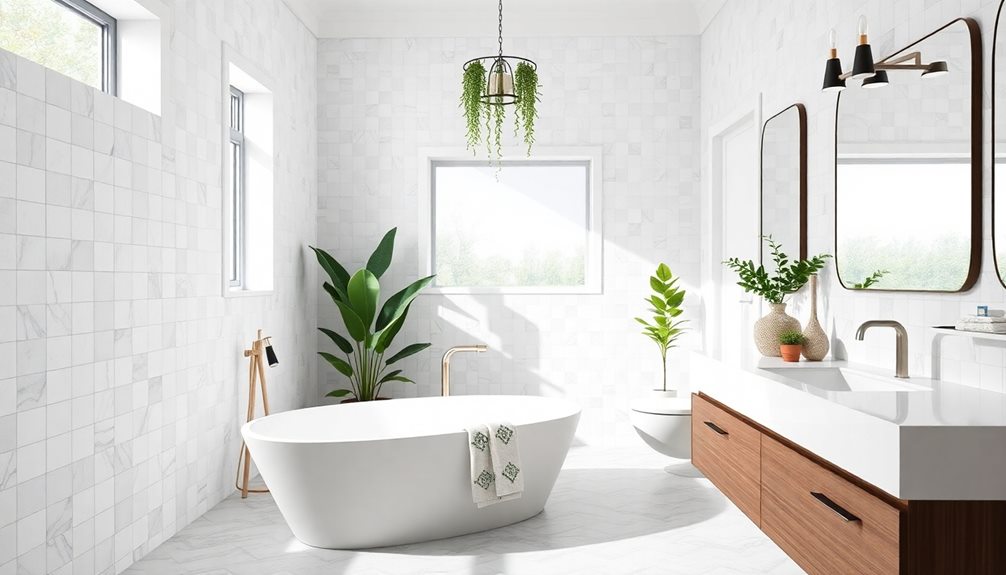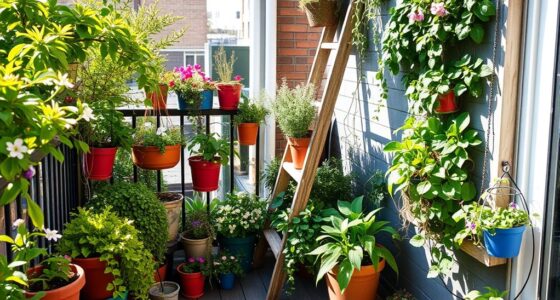Smart home integration makes your life easier by connecting various devices into a seamless network. Major platforms like Google Home, Amazon Alexa, and Apple HomeKit offer compatibility and ease of use. You can choose from Wi-Fi, Bluetooth, or dedicated smart hubs to guarantee your devices communicate effectively. Setting up is simple with manufacturer apps guiding you. Prioritize security by using strong passwords and enabling two-factor authentication. Enjoy benefits like energy efficiency and streamlined daily routines with automation. Interested in tips for maximizing your smart home experience? There's so much more to explore about creating your ideal connected space!
Key Takeaways
- Understand major smart home ecosystems like Amazon Alexa, Google Home, and Apple HomeKit for optimal device compatibility and functionality.
- Utilize various connectivity options such as Wi-Fi, Bluetooth, and dedicated smart hubs for efficient device integration.
- Implement smart hubs to centralize control, streamline device management, and enhance automation routines.
- Prioritize security and privacy with strong passwords, two-factor authentication, and regular firmware updates on all smart devices.
- Leverage automation routines and energy-efficient devices to enhance convenience and reduce utility costs in your smart home.
Smart Home Ecosystems
When you immerse yourself in the world of smart home ecosystems, you'll find major platforms like Google Home, Amazon Alexa, and Apple HomeKit, each offering distinct features tailored to different user needs.
Amazon Alexa stands out with its extensive range of compatible smart devices and third-party Skills, making it a go-to choice for those seeking versatility. If you prefer voice assistants, Alexa's robust support guarantees you can control your home seamlessly.
On the other hand, Google Home excels in voice recognition and can execute complex commands, making it particularly appealing to Android users who enjoy voice-activated control. Its integration with various smart devices enhances your experience, allowing you to manage everything effortlessly.
For iPhone users, Apple HomeKit provides a secure environment for controlling third-party devices. Its focus on security and privacy means you can trust that your data is protected, while enjoying smooth interoperability.
With the introduction of the Matter protocol, universal compatibility among smart devices is becoming a reality. Supported by over 200 companies, Matter enhances integration across these smart home ecosystems, guaranteeing a more cohesive smart home experience for you.
Device Connectivity Options

When setting up your smart home, you'll find several connection technologies at your disposal, each with its own benefits.
Smart hubs can streamline your device management, while Wi-Fi and low-power options like Zigbee and Z-Wave cater to different needs.
Understanding these connectivity options helps you create a seamless and efficient smart home experience.
Connection Technologies Overview
Smart home devices connect through various technologies, each offering distinct advantages depending on your needs. Wi-Fi is the most common choice, providing broad coverage and the ability to connect multiple devices. However, it requires a stable internet connection for peak performance.
If you're looking for something with a limited range, Bluetooth may work for you, especially for devices that don't need constant internet access. Additionally, incorporating top smart home devices can greatly enhance appliance functionality and improve your overall automation experience.
Dedicated smart hubs, like those using ZigBee or Z-Wave protocols, can enhance device connectivity by minimizing Wi-Fi congestion and boosting responsiveness. These hubs create a more reliable environment for your smart home automation systems.
The Thread protocol, on the other hand, allows devices to form mesh networks, enabling efficient communication without relying on a central hub. This is particularly beneficial in larger setups where maintaining connectivity can be a challenge.
Lastly, Matter is revolutionizing smart home integration by ensuring universal compatibility among devices. This means you can mix and match different brands and platforms, simplifying your smart home experience.
Smart Hub Benefits
Integrating a smart hub into your setup can greatly enhance your smart home experience by streamlining device management. A smart hub acts as a centralized control system, allowing you to manage multiple smart devices from different manufacturers through a single interface. This not only simplifies automation but also improves reliability across your home network.
Popular smart hubs, like Amazon Echo and Google Home, support various connectivity protocols including Wi-Fi, Zigbee, and Z-Wave, ensuring seamless integration of diverse smart home products. By reducing congestion on your home Wi-Fi, these dedicated hubs boost responsiveness for real-time automation and control.
With a smart hub, you can easily create automation routines that trigger multiple devices based on specific conditions, such as time of day or user presence. In addition, they enhance your voice command functionality, letting you control grouped devices with a single command.
This streamlining enhances your interaction within the smart home ecosystem, making daily tasks simpler and more efficient. Embracing a smart hub truly transforms your smart devices into a cohesive unit, maximizing the potential of your home automation setup.
Setting Up Smart Devices

Ensuring ideal placement of your smart devices is key for reliable Wi-Fi connectivity, which is essential for their performance. Position devices away from thick walls or electronic interference to maintain a strong signal.
Consider integrating your smart home with energy-efficient systems like heat pumps, which can improve overall comfort while also enhancing your indoor air quality. Start your setup using the manufacturer's app, where you'll find guided instructions for a smooth installation process.
Once your devices are connected, make sure to name and group them in your smart home app. This will streamline your voice commands and enhance automation routines. For instance, you might create a "Good Morning" routine that turns on lights and starts the coffee maker at your desired time.
Regularly check for firmware updates on your smart devices. These updates can address vulnerabilities, improve performance, and keep your devices functioning smoothly.
Additionally, consider programming devices based on specific triggers, like occupancy detection, to maximize energy efficiency and convenience.
Security and Privacy Considerations

How can you protect your personal information while enjoying the convenience of smart home devices? First, implement strong privacy settings on each device. Since these devices often collect personal data, regularly review their data-sharing policies to minimize unauthorized access.
One effective security measure is to use strong, unique passwords for each smart device. Many cyberattacks exploit weak or reused credentials, so don't take shortcuts. Additionally, understanding your overall financial health, including aspects like trust creation net worth threshold, can help inform your investment in smart home technology that prioritizes security.
Next, enable two-factor authentication (2FA) on your smart home accounts. This adds an extra layer of protection against unauthorized access and greatly enhances your overall security.
Keeping your devices updated is also essential; regular firmware updates patch vulnerabilities that cybercriminals could exploit.
Be aware of potential privacy risks, especially with smart speakers that may feature continuous listening. Configure their privacy settings to deactivate any features that could compromise your security.
Benefits of Smart Home Automation

Smart home automation offers you enhanced convenience by letting you control your home's functions from anywhere, simplifying your daily routine.
Plus, with energy-efficient devices optimizing usage, you could save considerably on your energy bills.
Embracing this technology not only makes life easier but also promotes responsible energy consumption.
Enhanced Convenience
As you embrace smart home automation, you'll discover a world of enhanced convenience that simplifies daily living.
With a smart home setup, controlling devices like smart lighting and smart thermostats becomes a breeze. You can adjust your home's temperature and lighting remotely through your smartphone or with the help of a voice assistant, making your life easier.
Imagine programming your smart lighting to turn on automatically at sunset or using motion sensors to enhance security. Integrated systems allow you to create automation routines that adapt to your lifestyle, ensuring convenience and efficiency at every turn.
For instance, smart thermostats can adjust based on occupancy, which not only keeps you comfortable but also contributes to energy savings.
The rise of smart home technology reflects a growing demand for solutions that streamline daily tasks. As you incorporate these functionalities, you'll enhance your home's accessibility, particularly for those with mobility challenges, thanks to hands-free control options.
Ultimately, smart home automation isn't just about gadgets; it's about transforming your living space into a more convenient, efficient, and enjoyable environment.
Energy Efficiency Improvements
Over time, embracing smart home automation can greatly enhance your home's energy efficiency. By integrating smart thermostats, you can optimize heating and cooling schedules based on occupancy and preferences, which can lead to energy savings of 10-15% on your utility bills. Automated smart lighting systems help reduce energy consumption by turning off lights in unoccupied rooms and using energy-efficient LED bulbs.
Here's a quick look at how different smart devices contribute to energy efficiency:
| Device Type | Benefits | Energy Savings |
|---|---|---|
| Smart Thermostats | Optimize heating/cooling schedules | 10-15% on utility bills |
| Automated Smart Lighting | Turn off lights in unoccupied rooms | considerable savings over time |
| Smart Appliances | Run during off-peak hours | Lower electricity rates |
Energy monitoring systems allow you to track real-time usage, helping you identify and reduce energy waste. Additionally, smart power strips manage phantom loads from devices in standby mode, further enhancing energy efficiency. By leveraging these technologies, you can considerably reduce your energy consumption and enjoy substantial energy savings in the long run.
Future Trends in Smart Homes

In the coming years, the smart home landscape is set to transform dramatically, with the global market projected to hit $174 billion by 2025. This surge is driven by advancements in technology and increased consumer adoption of smart devices.
You'll see a significant rise in artificial intelligence integration, enabling your smart home automation system to learn your preferences and automate tasks more intuitively.
Interoperability will also improve, thanks to the Matter protocol, which aims to simplify device connectivity across various ecosystems. This means your devices from different manufacturers will work seamlessly together, enhancing your overall experience.
Sustainability will take center stage, with smart home technologies incorporating energy-efficient solutions like smart meters and eco-friendly appliances to help reduce your carbon footprints.
Moreover, the growing adoption of 5G technology will revolutionize device communication, allowing for real-time data processing and faster response times. This means your smart home systems will perform even better, making your life easier and more efficient.
As these trends unfold, you can expect your smart home to become not just a convenience, but an essential part of a sustainable lifestyle.
Frequently Asked Questions
What Are the Best Smart Home Brands to Consider?
When choosing smart home brands, consider well-known names like Google Nest, Amazon Echo, Philips Hue, and Ring. They offer reliable products with strong ecosystems, making it easier for you to integrate and automate your home efficiently.
How Do I Choose the Right Smart Hub for My Home?
Over 70% of smart home users report increased convenience. To choose the right smart hub for your home, consider compatibility with your devices, ease of use, and features that align with your lifestyle and needs.
Can I Integrate Older Devices Into a Smart Home System?
Yes, you can integrate older devices into a smart home system. Use compatible adapters or hubs that bridge the gap between traditional technology and smart systems, allowing you to control everything seamlessly from one platform.
What Are Common Troubleshooting Tips for Smart Home Devices?
When tech feels like it's from a sci-fi movie gone wrong, don't panic! Restart your devices, check connections, guarantee firmware updates, and reset your network. These steps often breathe life back into your smart home.
How Can I Improve My Smart Home's Energy Efficiency?
To improve your smart home's energy efficiency, optimize device settings, schedule usage during off-peak hours, invest in smart thermostats, and regularly update firmware. These steps help you save energy and reduce costs effectively.
Conclusion
As you immerse yourself in the world of smart home integration, think of it like planting a garden—you'll reap the rewards with a little care and attention. By understanding ecosystems, connectivity, and security, you're setting the stage for a more convenient and efficient lifestyle. Embrace the benefits and keep an eye on future trends, because the smart home landscape is always evolving. So, get ready to transform your living space into a tech-savvy haven!









